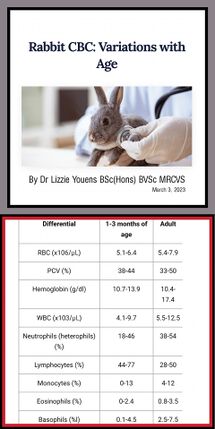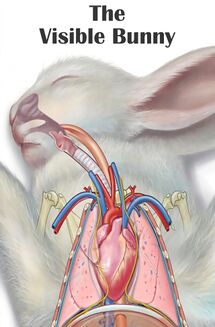Basic biological data
Physiologic Values
| Life span: | 6–13 years |
| Urine volume: | 20–250 mL/kg/24 h. Usually about 130 ml/kg/24 h |
| Water intake: | 50–100 mL/kg/24 h |
| Oxygen use | 0.4–0.85 mL/g/hr |
| Optimum environmental temperature: | 15–20°C (65–70°F) |
Rectal temperature:
|
38.5–40°C (103.3–104°F) 38.0°C (100.4°F) 40.6°C (105°F) |
| Heart rate: | 130–325 bpm |
| Respiratory rate: | 32–60 bpm |
| Erythrocyte life span: | 50 days |
| Blood volume: | 55–65 mL/kg |
| Blood pressure: | 90–130/60–90 mm Hg |
| Tidal volume: | 20 mL (4–6 mL/kg) |
| Gastrointestinal transit time: | 4–5 hr |
| Intraocular pressure: | 5–23 mmHg |
| Reproductive data | |
| Puberty: | 4–5 months in small breeds 5–8 months in large breeds |
| Descent of testicles: | 10–12 weeks |
| Age at which to neuter: | >3 months for males; >5 months for females |
| Interval between castration and infertility: | 4 weeks |
| Pregnancy diagnosis: | Palpation: 10–12 days Radiologically after 11 days |
| Gestation: | 30–32 days |
| Litter size: | Average 5–8 |
| Milk composition: | 13–15% protein, 10–12% fat and 2% carbohydrate |
| Birth weight: | 40–100 g |
| Eyes open: | 7 days |
| Weaning: | 4–6 weeks |
| Sources:
Harcourt-Brown, F. (2001). Textbook of rabbit medicine. (1st ed.). | |
Serum Biochemistry Values

| Serum protein | 2.8–10.0 g/dL |
|
2.7–4.6 g/dL |
|
1.5–2.8 g/dL |
|
0.2–0.4 g/dL |
| Serum glucose | 75–150 mg/dL |
| Blood urea nitrogen (BUN) | 15.0–23.5 mg/dL |
| Creatinine (Cr, CREAT) | 0.5–2.5 mg/dL |
| Total bilirubin (T Bil) | 0.25–0.74 mg/dL |
| Serum lipids | 280–350 mg/dL |
| Phospholipids | 75–113 mg/dL |
| Triglycerides (TGL, Trig) | 124–156 mg/dL |
| Cholesterol | 18–35 mg/dL |
| Calcium (Ca) | 5.6–12.5 mg/dL |
| Phosphorus (PHOS, PO4) | 4.0–6.9 mg/dL |
| Alanine aminotransferase (ALT) | 48–80 U/L |
| Aspartate aminotransferase (AST) | 14–113 U/L |
| Alkaline phosphatase (ALP, AP, Alk Phos) | 4–16 U/L |
| Source:
Oglesbee, B. (2011). Blackwell's five-minute veterinary consult: Small mammal. (2nd ed.). | |
Hematologic Values
| Erythrocytes | 4–7.2 × 106/mm3 |
| Hematocrit | 36–48% |
| Hemoglobin | 10.0–15.5 mg/dL |
| Leukocytes | 7.57–13.5 × 103/mm3 |
|
20–35% |
|
55–80% |
|
1–4% |
|
2–10% |
| Platelets | 200-–1000 × 103/mm3 |
| Source:
Oglesbee, B. (2011). Blackwell's five-minute veterinary consult: Small mammal. (2nd ed.). | |
Further Reading
Rabbit CBC: Variations with Age, Dr Lizzie Youens BSc(Hons) BVSc MRCVS, March 3rd, 2023
Hormone Values
| T3 - Triiodothyronine T3 3,3',5-triiodo-L-thyronine |
130–143 ng/dL [1.997–2.1967 nmol/L] (Suckow, 2012) |
| T4 - Thyroxine T4 3,5,3',5'-tetraiodothyronine |
1.7–2.4 μg/dL [21.9–30.9 nmol/L] (Suckow, 2012) 1.7–2.4 μg/dL [21.9–30.9 nmol/L] (Laboklin, Dec 2017) 3.9–5.3 μg/dL [50.9–68.2 nmol/L] (Laboklin, Sep 2017) 6.4–8.3 μg/dL [82.4–106.8 nmol/L] (Jones, 1975) |
| Source:
Suckow, Stevens, & Wilson (2012). The Laboratory Rabbit, Guinea Pig, Hamster, and Other Rodents (American College of Laboratory Animal Medicine). (1st ed.).
| |
The Visible Bunny App
This app allows users to view different aspects of the bunny's anatomy to fit their needs. It is especially useful for a surgeon to show clients where and they might be working by turning on particular layers of the bunny's anatomy. Along with showing different views of the anatomy, this app also allows the user to draw on top of the image. This feature can aid the user in circling certain parts of the anatomy, or writing text. There is also a save image feature that allows the user to save views to their device, which can be sent via email or text at a later date. These images are saved in a folder called The Visible Bunny in the Android pictures folder.
The Visible Bunny is offered by the College of Veterinary Medicine at the University of Georgia - Educational Resources Center (James Moore).
- Android (requires Android 5.0 and up) Play Store
- Apple iPhone, iPadOS, and iPod touch (requires iOS 12.0 or later) & Mac (requires macOS 11.0 or later & a Mac with Apple M1 chip) - Apple Store


